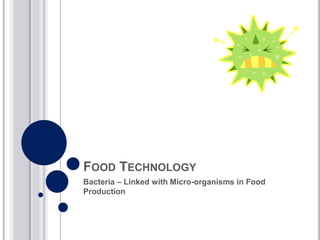
Micro-organism in Food Production
- 1. FOOD TECHNOLOGY Bacteria – Linked with Micro-organisms in Food Production
- 2. SALMONELLA Is a genus of rod-shaped, Gram negative, spore forming bacteria. Incubation period: 12-72 hours Duration f Illness: 4-7 days but can cause more serious illness in older adults, infants and persons with chronic diseases. Symptoms: Diarrhoea, fever, abdominal cramps and vomiting Sources: Contaminated eggs, poultry, meat, unpasteurised milk and juice, cheese, contaminated raw fruits and vegetables. To prevent contamination: Cook foods above the ‘danger zone’ (5-65°C) to kill micro- organisms Wash hands thoroughly Keep food properly refrigerated Separate cooked and uncooked food, and use separate utensils for each.
- 3. LISTERIA MONOCYTOGENES Is a Gram-positive bacterium found in soil and water and some animals, including poultry and cattle. Incubation period: 3-70 days Duration to illness: Days to weeks Symptoms: Fever, stiff neck, confusion, vomiting, sometimes diarrhoea. Sources: Refrigerated pates or meat spreads, unpasteurised milk and day products, raw sprouts, ready-to-eat deli meats and hot dogs. Who’s at risk: Older adults, pregnant women, people with certain diseases (cancer, liver disease, HIV/AIDS). Due to frequent pathogenetically, causing meningitis in newborns, pregnant mothers are advised not to eat soft cheeses (brie and feta for example). To prevent contamination: Do not drink raw (unpasteurized) milk, and do not eat foods that have unpasteurized milk in them. Wash hands, countertops, and utensils after handling and preparing uncooked foods. Keep uncooked meats, poultry separate from vegetables, fruits, cooked foods, and ready-to-eat foods.
- 4. CAMPYLOBACTER Is a genus of bacteria that are Gram-negative, spiral in shape and microaerophilic. Sources: Raw and uncooked poultry, unpasteurised milk, contaminated water. Symptoms: Diarrhoea, cramps, fever and vomiting, diarrhoea may be bloody. Incubation period: 2-5 days Duration of illness: 2-10 days. To prevent contamination: Always cook meat, especially poultry, to safe minimum temperatures. Keep raw meat separate from other foods. Do not drink unpasteurised milk.
- 5. STAPHYLOCOCCUS AUREUS Type of bacteria commonly found on the skin and hair as well as in the noses and throats of people and animals. Cause food poisoning when a food handler contaminates food and then the food is not properly refrigerated. Sources: Salads, such as ham, egg, tuna, chicken, potato, and bakery products, such as cream-filled pastries and cream pies Incubation period: 1-6 hours Duration of illness: 24-48 hours Symptoms: Nausea, vomiting, diarrhoea, loss of appetite, sever abdominal cramps, mild fever To prevent contamination: Wash hands and under fingernails vigorously with soap and water before handling and preparing food. Keep kitchens and food-serving areas clean and sanitized. Store cooked food in a wide, shallow container and refrigerate as soon as possible.
- 6. ESCHERICHIA COLI (E COLI) Is a Gram-negative bacillus which can grow both aerobically and anaerobically. Sources: Gut of humans and warm-blooded animals, sewage, water and raw meat. Symptoms: Abdominal cramps, vomiting, diarrhoea and in some people haemorrhagic colitis (bleeding of the bowel). Occasionally however, particularly in young children, haemolytic uraemic syndrome (HUS) develops. This is a condition which leads to kidney failure and death is 5-10% o cases. HUS takes 1 – 2 weeks to develop. Incubation period: 1-6 days Duration of Illness: 5-10 days To prevent contamination: Hygienic slaughtering practices reduces contamination of carcasses by faeces Vulnerable populations (e.g. Children or Elderly) should avoid consumption of raw/ undercooked meat or milk/ milk products. Cook all meat to at least 72°C. Wash fruit and vegetables.
- 7. CLOSTRIDIUM PERFRINGENS It is an anaerobic, spore forming bacillus. Food poisoning caused by this bacterium is due to eating a food containing large numbers of living bacteria which subsequently release a toxin in the intestine. Sources: Raw meat and poultry – bacteria from raw meat may spread to cooked food through cross contamination. Food handlers, insects and reheated food can contaminate. Symptoms: Nausea, Abdominal pains, Diarrhoea and Vomiting (although this is rare) Incubation period: 8-22 days Duration of Illness: 12-48 hours To prevent contamination: Since this bacteria form heat-resistant spores it cannot be assumed that the bacteria are killed during cooking. In order to lower the risk of clostridium perfringers, the following precautions should be taken: Joints of meat (+3Kg) should be cut into smaller pieces before cooking. Raw and cooked meats stored separately. Reheating of meat should be avoided if possible. If necessary the meat should be heated and served quickly.
- 8. CLOSTRIDIUM BOTULINUM A Gram-positive, anaerobic, spore-forming bacillus. Produces an exotoxin whilst growing in food and is one of the most lethal poisons known. Illness caused by the organism Botulism. Sources: Soil, some fish and vegetables and some canned, bottled and vacuum packed foods. Symptoms: Toxin affects central nervous system. Early symptoms include double vision, difficulty with speech, headache and dizziness. Incubation period: 18-36 hours Duration of Illness: 1-8 days To prevent contamination: Botulinum toxin is destroyed by heat. Heating to 80°C for 15 minutes is sufficient to destroy the toxin.
- 9. BACILLUS CEREUS A Gram-positive, spore-forming, aerobic bacillus. It produces a heat-resistant exotoxin which is released into food. The toxin can survive for 1.5 hours at 121°C. Sources: Soil, dust and water. Frequently present in cereal foods – particularly rice and cornflour. Some rice dishes (boiled and fried) and milk puddings. Symptoms: Vomiting, abdominal pains and some diarrhoea. Incubation period: 1-6 hours Duration of Illness: 6-24 hours To prevent contamination: Rice dishes, milk puddings and cornflour sauces should be cooled quickly (within 90 minutes). Re-heating food should be heated quickly and thoroughly and served as soon as possible.